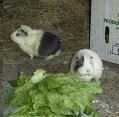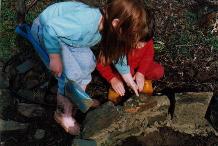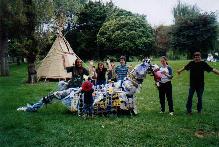 |
Bungala Ridge Permaculture Gardens REDUCE ... REUSE ... RECYCLE ... REPAIR ... RETURN ... REVEGETATE ... REPLENISH |
||||||||||||||
|
|||||||||||||||
|
|
Children Learning Naturally Permaculture is more than a design tool for agriculture and gardening - it is a design tool for life based on the following ethics:care of the earth Home education practice grows out of the values that families hold dear. The above permaculture ethics are at the heart of our family values and form the basis of all of our learning activities. Everything we do in life must satisfy these three permaculture ethics. We use permaculture as are our guide in designing educational activities and opportunities for our family. The key guiding principles for permaculture action are: reduce, reuse, recycle, In effect this means carefully accounting for the energy entering and leaving our learning systems - making sure we utilise all resources appropriately and efficiently according to the above principles. This includes all social and material resources, interpersonal and intrapersonal resources and our entire physical environment. It means treading lightly and thoughtfully on the planet. We also are aware that whatever is used must be paid for - we are accountable for our actions to every living thing and to the future. The development of personal and community responsibility is a natural outcome of a permaculture focus. Permaculture encourages the development of low maintenance systems using beneficial guilds that are supportive, cooperative structures built on diversity - or more simply phrased - multiple elements fulfilling multiple functions on many levels. This is easy to achieve using a learning naturally approach to home education. learning naturally We take advantage of the naturally occurring interactions in every day life, capitalising on, recognising and celebrating the learning packed into every moment of life. There is seldom any need to 'contrive' learning experiences - a full and busy life is full of immediately useful and relevent learning experiences. Permaculture offers a rich and complete learning curriculum for people of all ages. We celebrate conflict as the 'edge' - where elements and systems meet, giving rise to unparalleled opportunity for growth, cooperation, creativity and order. Rather than seeing conflict as a problem we see it as a challenge to grow and learn beyond a fixed 'mind-set'. We recognise that the problem is the solution - that everything works both ways - and that a positive, constructive attitude is the key to building successful learning activity. By turning a problem around and thinking about it creatively we often evolve innovative solutions that take us in more people and Earth friendly directions! Using a permaculture design paradigm requires us to always make the least change for the greatest possible effect, ensuring energy and resource utilisation efficiency. This works toward eliminating 'waste' - with attention given to getting the maximum use of any resource, be it time, energy, materials or social resources. This trimming down of excess is especially applicable to educational programs! We think carefully about our needs and our wants, our inputs and intended and possible unintended outcomes before taking action. The aim in permaculture is always to increase yields, accounting for all energy inputs and outcomes. We realise life and learning are cyclic in nature and that increases in cycling increases the total possible yields. Making connections is a key feature of our learning regime. In permaculture stability is derived from mutually beneficial connections between a number of diverse elements and functions within a system. In our home learning program we connect learning into a continuous whole, rejecting the more common practice of segmenting the curriculum into subjects and lessons. The role of a successful permaculture design is to create a self-managed, sustainable system. The aim of education is to create individuals who can operate and function as citizens in society, independently and cooperatively. Permaculture offers a clear blueprint for excellence in education, in every area of human endeavor. For more information about home education visit Homeschool Australia
|
Hot Links!
This site is sponsored by
|
|||||||||||||
|
|
|
|
|||||||||||||





 Respecting and caring for the environment and all living things.
Respecting and caring for the environment and all living things. 









 Designing and building landcapes comes naturally through play.
Designing and building landcapes comes naturally through play.  "Junkasaurus" - a recycled garbage community art project.
"Junkasaurus" - a recycled garbage community art project. 
